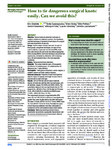How to tie dangerous surgical knots: easily. Can we avoid this?
| dc.contributor.author | Drabble, E | |
| dc.contributor.author | Spanopoulou, S | |
| dc.contributor.author | Sioka, E | |
| dc.contributor.author | Politaki, E | |
| dc.contributor.author | Paraskeva, I | |
| dc.contributor.author | Palla, E | |
| dc.contributor.author | Stockley, Lauren | |
| dc.contributor.author | Zacharoulis, D | |
| dc.date.accessioned | 2021-07-27T13:27:08Z | |
| dc.date.available | 2021-07-27T13:27:08Z | |
| dc.date.issued | 2021-07 | |
| dc.identifier.issn | 2631-4940 | |
| dc.identifier.issn | 2631-4940 | |
| dc.identifier.other | e000091 | |
| dc.identifier.uri | http://hdl.handle.net/10026.1/17379 | |
| dc.description.abstract |
<jats:sec><jats:title>Objective</jats:title><jats:p>Secure knots are essential in all areas of surgical, medical and veterinary practice. Our hypothesis was that technique of formation of each layer of a surgical knot was important to its security.</jats:p></jats:sec><jats:sec><jats:title>Design</jats:title><jats:p>Equal numbers of knots were tied, by each of three groups, using three techniques, for each of four suture materials; a standard flat reef knot (FRK), knots tied under tension (TK) and knots laid without appropriate hand crossing (NHCK). Each knot technique was performed reproducibly, and tested by distraction with increasing force, till each material broke or the knot separated completely.</jats:p></jats:sec><jats:sec><jats:title>Setting</jats:title><jats:p>Temporary knot tying laboratory.</jats:p></jats:sec><jats:sec><jats:title>Materials</jats:title><jats:p>The suture materials were, 2/0 polyglactin 910 (Vicryl), 3/0 polydioxanone, 4/0 poliglecaprone 25 (Monocryl) and 1 nylon (Ethilon).</jats:p></jats:sec><jats:sec><jats:title>Participants</jats:title><jats:p>Three groups comprised, a senior surgeon, a resident surgeon and three medical students.</jats:p></jats:sec><jats:sec><jats:title>Outcome measures</jats:title><jats:p>Proportion of each knot type that slipped, degree of slippage and length of suture held in loop secured by each knot type.</jats:p></jats:sec><jats:sec><jats:title>Results</jats:title><jats:p>20% of FRK tied with all suture materials slipped; all knots tied with the other two techniques, with all materials, slipped, TK (100%) and NHCK (100%). The quantitative degree of slip was significantly less for FRK (mean 6.3%–, 95% CI 2.2% to 10.4%) than for TK (mean 312%, 95% CI 280.0% to 344.0%) and NHCK (mean 113.0%, –95% CI 94.3% to 131.0%).</jats:p><jats:p>The mean length of suture in loops held within (FRK mean 25.1 mm 95% CI 24.2 to 26.0 mm) was significantly greater than mean lengths held by the other techniques (TK mean 17.0 mm, 95% CI 16.3 to 17.7 mm), (NHCK mean 16.3 mm, 95% CI 15.9 to 16.7 mm). The latter two types of knot may have tightened more than anticipated, in comparison to FRK, with potential undue tissue tension.</jats:p></jats:sec><jats:sec><jats:title>Conclusion</jats:title><jats:p>Meticulous technique of knot tying is essential for secure knots, appropriate tissue tension and the security of anastomoses and haemostasis effected.</jats:p></jats:sec> | |
| dc.format.extent | e000091-e000091 | |
| dc.format.medium | Electronic-eCollection | |
| dc.language | en | |
| dc.language.iso | en | |
| dc.publisher | BMJ | |
| dc.subject | device safety | |
| dc.subject | medical errors | |
| dc.subject | technology | |
| dc.title | How to tie dangerous surgical knots: easily. Can we avoid this? | |
| dc.type | journal-article | |
| dc.type | Journal Article | |
| plymouth.author-url | https://www.ncbi.nlm.nih.gov/pubmed/35047808 | |
| plymouth.issue | 1 | |
| plymouth.volume | 3 | |
| plymouth.publication-status | Published | |
| plymouth.journal | BMJ Surgery, Interventions, & Health Technologies | |
| dc.identifier.doi | 10.1136/bmjsit-2021-000091 | |
| plymouth.organisational-group | /Plymouth | |
| plymouth.organisational-group | /Plymouth/Faculty of Health | |
| plymouth.organisational-group | /Plymouth/Faculty of Health/Peninsula Medical School | |
| plymouth.organisational-group | /Plymouth/Users by role | |
| plymouth.organisational-group | /Plymouth/Users by role/Academics | |
| plymouth.organisational-group | /Plymouth/Users by role/Researchers in ResearchFish submission | |
| dc.publisher.place | England | |
| dcterms.dateAccepted | 2021-06-23 | |
| dc.rights.embargodate | 2021-7-29 | |
| dc.identifier.eissn | 2631-4940 | |
| dc.rights.embargoperiod | Not known | |
| rioxxterms.funder | National Institute for Health Research | |
| rioxxterms.identifier.project | NIHR Pre-doctoral Fellowship | |
| rioxxterms.versionofrecord | 10.1136/bmjsit-2021-000091 | |
| rioxxterms.licenseref.uri | http://www.rioxx.net/licenses/all-rights-reserved | |
| rioxxterms.licenseref.startdate | 2021-07 | |
| rioxxterms.type | Journal Article/Review | |
| plymouth.funder | NIHR Pre-doctoral Fellowship::National Institute for Health Research |


